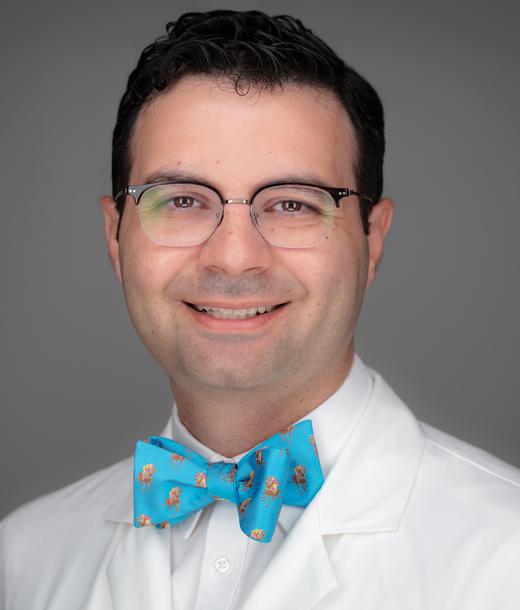Tafasitamab/Lenalidomide in R/R DLBCL Shows Benefit with Long-Term Use
In the second article of a 2-part series, Hayder Saeed, MD, discusses the long-term use of tafasitamab and lenalidomide in patients with diffuse large B-cell lymphoma and how the combination therapy compares in the real-world setting.
CASE
- A 67-year-old man presented with fatigue, back pain, and lymphadenopathy.
- Medical history: Hypertension, well controlled with medication
- Physical exam: Left posterior cervical, 1.5-cm node; right anterior cervical node, 2.5-cm; left supraclavicular node, 2.0-cm.
- PET-CT scan: multiple enlarged mesenteric and retroperitoneal nodes, largest measuring 5.3 x 3.1 cm
- Bone marrow biopsy was negative.
- Biopsy confirmed diffuse large B-cell lymphoma (DLBCL), non-germinal center B-cell, double expressor lymphoma.
- Immunohistochemistry positive for: CD20, BCL-6, BCL-2 (50% of cells), MYC (> 40% of cells), Ki67 85%, MUM1. Negative for CD10.
- Normal CBC
- Lactate dehydrogenase elevated
- Stage: III
- International Prognostic Index: high-intermediate risk.
- ECOG performance status: 1; non-germinal center
- Fluorescence in situ hybridization: negative for translocations involving MYC, BCL2, BCL6
- Six cycles of polatuzumab vedotin-piiq (Polivy) plus rituximab (Rituxan), cyclophosphamide, doxorubicin, and prednisone (R-CHP) was initiated, and back pain was resolved during treatment.
- Post-treatment PET scan demonstrated a complete response with a Deauville score of 2 the patient was observed.
- Eight months after completion of therapy, he complained of fever, night sweats, and back pain again.
- A palpable lymph node in the left groin was discovered on physical examination.
- PET and CT scan: new left inguinal lymph node, increase in size of residual node, as well as multiple metabolically active lesions in lymph nodes of the retroperitoneum, abdomen, and pelvis.
- Biopsy confirmed DLBCL, but next-generation sequencing (NGS) was not performed.
- The patient was referred to nearest transplant and cellular therapy center for evaluation, but ultimately opted not to pursue chimeric antigen receptor (CAR) T-cell therapy.
- The patient prefers to stay with current care team but is still seeking further treatment. However, he wants to receive outpatient treatment due to lack of support system.
Targeted Oncology: How did patients in the L-MIND (NCT02399085) study do after stopping treatment with tafasitamab (Monjuvi) and lenalidomide (Revlimid)?
HAYDER SAEED, MD: Despite the recommendation for this regimen being to continue as long as the patient is responding and in remission, some patients stopped treatment while in remission and continue to maintain their treatment response.1 We're talking about 24-, 36-, 48-, and 60-months of [response and remission].... Out of the 80 patients who were enrolled in the trial 25% of them had a good response to treatment [after stopping]. Patients who stop treatment while in response will still have a good remission even off treatment.1
What was the toxicity profile of this therapy in patients with relapsed/refractory (R/R) DLBCL?
The toxicity was what we expect. Tafasitamab is a naked [anti-CD19] antibody, so we don't expect it to cause any significant toxicity different than when we use rituximab long term, for example. When combined with lenalidomide, most of the toxicity was grade 1/2 hematological and non-hematological adverse events [AEs].1

This was mostly likely because lenalidomide was given in the first year [of treatment on this study], because subsequently when tafasitamab was given as monotherapy in the maintenance setting the toxicity rates, especially the non-hematological ones, went down significantly....1 That's what we expect with the naked antibody; we don't expect any significant AEs, but any significant AEs are mostly due to lenalidomide. Still, it's very manageable [overall] and we all use lenalidomide for patients with multiple myeloma regardless.
What real-world evidence supports the continued use of this regimen?
There was real-world evidence that…showed the response rates were much lower than what we've seen in the L-MIND trial.2 However, if you look at the patients enrolled in that real-world cohort, they had very refractory disease, different than what you would expect, or different than what we would probably prefer for patients on [this treatment]. Those patients with R/R DLBCL would be on third- or fourth-line therapy and post CAR T-cell therapy, and we don't anticipate them to have great responses.... There are now more data that are more consistent [with the results of the L-MIND study]…which showed the overall response rates are still higher [with this combination], but that's mostly in patients who received it in the second or third line.3 Also, the results were consistent that the sooner you use [this therapy], the better for these patients.
References:
1. Duell J, Abrisqueta P, Andre M, et al. Tafasitamab for patients with relapsed or refractory diffuse large B-cell lymphoma: final 5-year efficacy and safety in the phase II L-MIND study. Haematologica. 2023. doi:10.3324/haematol.2023.283480
2. Qualls D, Lambert N, Caimi P, et al. Tafasitamab and lenalidomide in large B cell lymphoma: real-world outcomes in a multicenter retrospective study. Blood. 2023. doi:10.1182/blood.2023021274
3. Duell J, Dreyling M, Gaidano G, et al. Estimates of survival and life expectancy with tafasitamab plus lenalidomide in the L-Mind study compared with real-world standard-of-care for patients with relapsed/refractory diffuse large B-cell lymphoma. Blood. 2023;142(1):6286. doi:10.1182/blood-2023-174043